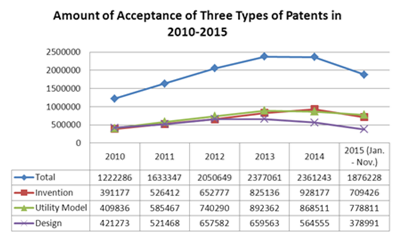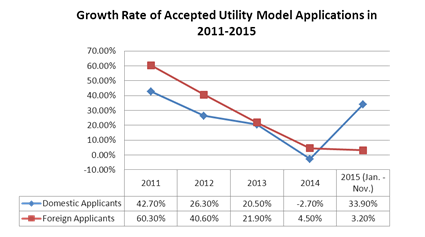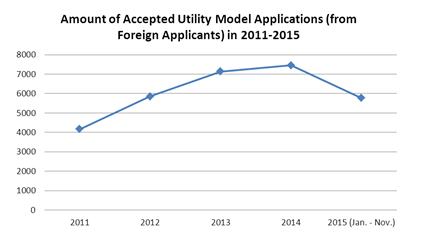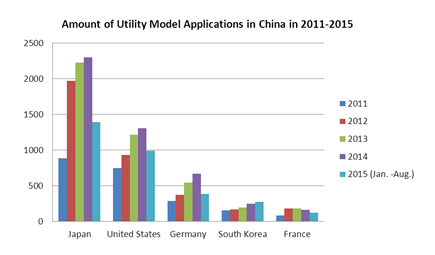Updates on Utility Model Applications in China
1. Data from January to November, 2015
According to the data of SIPO Patent Application and Management Monthly Statistics (
http://www.sipo.gov.cn/tjxx/tjyb/), China accepted 2,399,894 patent applications (including invention, utility model and design) in total from January to November, 2015, with a year-on-year increase of 19% from the total amount of 2,015,267 patent applications in the same period of 2014. Therein, 2,255,829 applications were from China domestic applicants, increasing by 20%, and 144,065 applications were from foreign applicants, increasing by 6%.
Among all the applications, there were 931,247 invention applications with a 19% increase from the same period of 2014, 975,645 utility model applications with a year-on-year increase of 31%, and 493,002 design applications with a year-on-year increase of 1%.
Table 1 Accepted Utility Model Applications in 2014 and 2015
2. Comparison of data of 2010-2015
As shown from the chart below, the amount of utility model applications is approximately the same with that of invention applications. The amount of utility model applications grew year by year, and only dropped by 3% in 2014.

As shown from the chart below, the growth rate of the amount of accepted utility mode applications reduced year by year from 2011 to 2014, but grew remarkably in 2015. The fluctuation of the growth rate of the amount of utility mode applications from foreign applicants is less intensive than that from domestic applicants. Although the application amount of domestic applicants dropped by 2.70% in 2014, yet the application amount of foreign applicants still increased by 4.5%. In addition, due to the huge amount of domestic utility model applications, the total rate of increase was basically the same with that of the domestic rate of increase.

 Note: Utility model applications from foreign applicants still only take a small proportion of the total amount of utility model applications of China (0.7-0.9% based on the data of 2011-2015), which is much lower than that of invention applications (14% based on the data of 2013-2015).
Note: Utility model applications from foreign applicants still only take a small proportion of the total amount of utility model applications of China (0.7-0.9% based on the data of 2011-2015), which is much lower than that of invention applications (14% based on the data of 2013-2015).
From 2011 to 2015, applicants from Japan, United States, Germany, Germany, South Korea and France filed the most utility model applications in China among all the foreign applicants.
 3. Period for examination
3. Period for examination
According to the Annual Report of SIPO (
http://www.sipo.gov.cn/gk/ndbg/), the period for examination of utility model applications in China is around four months and is shortening year by year, with 4.7 months in 2011, 4.4 months in 2012, 4.3 months in 2013, and 3.5 months in 2014.
In comparison, the examination period for invention applications is much longer. According to data of SIPO from 2011 to 2014, the examination period for invention applications is around 22 months (starting from the substantive examination).
4. Reasons for the huge amount of utility model applications
Concerning the reasons for the huge amount of utility model applications, the writers believe that the following two factors are playing the crucial roles.
(1) Utility model applications are easier and quicker to grant while the fees are lower.
Invention applications would be published in 18 months from the filing date (priority date), go through the substantive examination, and finally enter the procedure of granting. In comparison, utility model applications do not need to go through the substantive examination and would enter the procedure of granting directly after the preliminary examination. Therefore, the grant of utility model applications is easier and quicker.
Compared with invention applications, utility model applications have lower official expenses (lower application fees, no fees for substantive examination, and lower annual fees) and lower attorney fees (drafting fees are generally lower than those for invention applications, and there are generally no fees related to responses to Office Actions); therefore, the application fees are lower.
(2) Protecting force of utility model patent is not significantly different from that of invention patent.
The protecting force of utility model patent (for example, the amount of damages for infringement) is not significantly different from that of invention patent, no matter seen from the Patent Law or from the judicial practice.
The major differences between invention patent and utility model patent are: the term of validity of invention patent is 20 years while the term of validity of utility model patent is 10 years; and invention patent protects both products and methods while utility model patent only protects products.
In 2014, the Patent Reexamination Board accepted 3,422 requests for announcement of invalidation, seeing an increase of 492 requests with an increase rate of 16.8%. Therein, 747 requests for announcement of invalidation were related to invention patents, accounting for 21.8% of the total amount, and 1,525 requests for announcement of invalidation were related to utility model patents, accounting for 44.6% of the total amount. As enforcement of rights often lies behind the cases of announcement of invalidation, therefore judged from the above data, the enforcement of utility model patent right is also rather active.
Someone asserts that utility model patents are not stable as they do not go through the substantive examinations. The ground for such idea may be: for utility model patents, applicants do not amend the claims in utility model applications based on the prior art searched by examiners and comments on novelty and inventiveness raised by examiners, so the claims may not possess novelty or inventiveness. However, such problem can be solved through search and analysis when drafting the utility model applications.
On the other hand, according to the Chinese Patent Law, the degree of inventiveness required by utility model is lower than that required by invention; therefore for the same claims, utility model patent would be more difficult to invalidate.
In conclusion, utility model has broad market and fertile soil in China, so it is worthwhile for applicants from various countries to pay more attention to and utilize the utility model application reasonably.







